Field Verification of On-Line Hydrocarbon Dew Point Measurements
|
Andy Benton, Technical Consultant, Michell Instruments Limited, Ely, UK
 
|
|
|
Introduction |
The Michell Condumax II applies a fundamental measurement
principle for direct measurement of hydrocarbon dew point.
Measurement performance is assured through comprehensive factory
test and calibration, to verify that each analyzer offers accurate
determination of the temperature at which hydrocarbon condensate
forms. Further extensive examination confirms highly sensitive
detection response to the fractional condensation characteristics of
natural gas from within the onset of a measureable hydrocarbon dew
point within the lowest region of condensate in gas density.
Over the last three decades of Michell’s experience for this critical
gas quality parameter, a number of methodologies have evolved to
verify and maintain the performance of our analyzers in the field. Such
methods are explored below, including the ability to harmonise the
measurement sensitivity of the Condumax II to a specific customer designated
reference. |
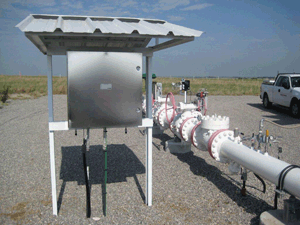 |
Factory Calibration and Field Verification Methods
|
|
|
Hydrocarbon dew point is defined in ISO 14532: 2001 – Natural Gas
Vocabulary as ‘the temperature above which no condensation of
hydrocarbons occurs at a specified pressure’. The Michell Condumax II
applies an adaptation of the fundamental cooled-mirror principle for the
direct measurement of hydrocarbon (HC) dew point. The unique ‘Dark
Spot’ detection principle offers a degree of sensitivity and repeatability
that cannot be achieved through indirect estimations of this parameter
derived from equation-of-state calculation from composition analysis or
through direct measurements using a manually operated chilled-mirror
dew point apparatus. Since its first introduction in 1985, the Condumax
I/II have become established as the industries’ leading analyzer for
policing this key contractual specification parameter of gas quality with
gas producers and transmission pipeline operators both across the
European network and elsewhere in the world.
|
Although the Condumax II applies fundamental principles to a high
degree of sensitivity the measurement of HC dew point differs from
other parameters in that no metrology standards exist against which
traceable calibration can be maintained. This calls into question how the
calibration of an automatic HC dew-point analyzer can be maintained
in field service, which is achieved in a number of ways in the case of
the Condumax II, to fulfil applicable business practices for gas quality
standards and suit specific customer’s preferred practices.
The traditional field verification method applied to on-line automatic HC dew point analyzers is by periodic
comparison with manual visual measurements made using Bureau of Mines dew point apparatus or derivatives
thereof, such as the Chandler Dew Point Tester. Such spot-check manual measurements have the advantage of being a direct determination of HC dew point but with a reputation for being subjective due to high operator
dependence. The accuracy of such measurements is dependent on the skill of the operator to adhere strictly
to the correct procedure (ASTM D1142 Standard Test Method for Water Vapor Content of Gaseous Fuels by
Measurement of Dew-Point Temperature adapted from water to HC dew point measurement) and correctly
interpret the condensation formations observed on the cooled mirror, indentifying the HC condensate while
discriminating other formations such as glycol, water, ice, methanol and hydrates. This is a growing problem over
recent years as personal experienced in making such measurements is becoming rare.
|
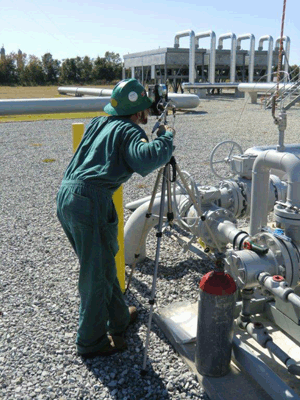
|
It is an increasing practice of some natural gas companies to perform
in-situ performance checks on their on-line HC dew point analyzers
using cylinder gas of certified composition provided by technical/
speciality gas suppliers. The form of gases applied varies from a high
purity single component hydrocarbon such as 100% n-propane, to a
binary mix of a hydrocarbon in a carrier gas such as 10% n-butane
in nitrogen. Alternatively, a synthesised natural gas mixture can be
applied, comprising up to 8 or more components from methane to
octane or even including a small single-figure ppm concentration of
nonane and decane. The HC dew point temperature versus pressure
relationship is predicted using an equation of state.
Such a methodology can be applied to good effect but special
consideration must be given to a number of important technical
aspects:
- Preparation of the cylinder through rolling and heated jacketing to
assure composition integrity in conformance to certification
- attention to the purity of individual components within the mixture
and the uncertainty of gravimetric certification
- the correct application of equation-of-state to derive predicted HC
dew point values and the uncertainty margin thereof
All these methods of field verification can be applied to the Michell Instruments’ Condumax II to fulfil individual
customer preference.
|
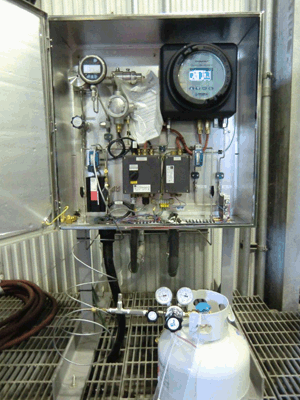
|
In some cases a customer may employ the specialist skills of the analyzer calibration laboratories at the Michell
factory to provide a replacement HC dew point Sensor Cell on an annual or biennial basis. The period varies as
recommended by the Michell depending on the severity of the application. For example, sour gas applications may
benefit from a more stringent performance and preventative maintenance schedule.
|
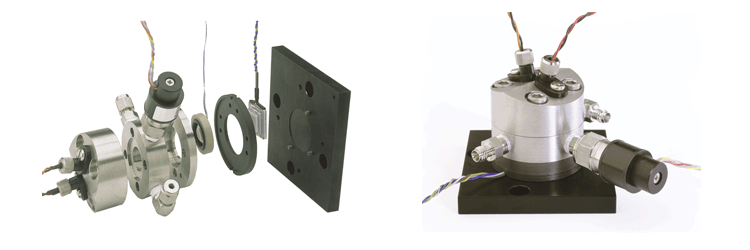
|
The sensor cell incorporates all the critical measurement components of the analyzer, including:
- Optical surface (mirror)
- Cooled surface temperature sensor
- Detection photo-electronics
- Peltier heat-pump
The replacement Sensor Cell will benefit from Michell’s factory calibration, the same as applied to newly-built
Condumax II analyzers, using three test gases carrying gravimetric certification (traceable to metrology mass
standards):
- A binary mixture of n-butane in a background of nitrogen. This gas has a precisely defined HC dew point
temperature versus pressure relationship, so enables confirmation of the accuracy of condensate formation
temperature over a wide range of temperatures from -30 to 20°C.
- & 3. Complex synthesised natural gas blends of compositions comprising methane to octane and methane to
decane. In addition to the gravimetric certification, the C1-C10 mixtures are calibrated by the UKAS1-accredited
laboratory in accordance with ISO 6143:2001 - Gas Analysis - Determination of Composition of Calibration Gas
Mixtures - Comparison Methods. These gases prove the sensitivity and repeatability of the analyzers’ ‘Dark Spot’
detection principle to respond to the minute fraction (order of single figure mg/m3) of low surface tension film that
forms in the onset to a measureable HC dew point
The replaced Sensor Cell taken from the field can be returned to Michell for refurbishment and re-calibration,
on a change-out rotation basis, so replenishing the customer’s site spares inventory while achieving an effective
preventative maintenance routine for the installed analyzer.
|
Harmonisation to Designated Measurement Sensitivity
Such field verification and performance maintenance methods applied to Condumax I and II have proven
satisfactory in meeting the needs of the natural gas production processing and pipeline transmission industries over
recent the last 30 years. None can be said to be an ideal reference given the superior detection sensitivity and
objective measurement repeatability for the Dark Spot detection principle of the Condumax II.
An exception to these methods is found with Gasunie Transport Services (GTS) in The Netherlands. Work carried
out by Gasunie Research from 2004 lead to an ISO Technical Report in 2008 defining a calibration method
for automatic HC dew point analyzers to a specific measurement sensitivity quantified in terms of mass of HC
condensate per unit volume of gas (so density of condensate in gas) occurring at the measured HC dew point and
prevailing analysis pressure. Gasunie apply a PHLC (Potential Hydrocarbon Liquid Concentration) value of 5mg/
Nm3, in accordance with the specific gas quality contractual specification applicable for their national gas supply
network. To implement this calibration practice in the field, Gasunie Research (now KEMA GCS) applied a specialist
analysis system they developed for pseudo on-line PHLC measurement using an automatic weighing method in
accordance with ISO6570 – Natural Gas – Determination of potential hydrocarbon liquid content – Gravimetric
methods. The sensitivity of the Condumax II is harmonised to the desired PHLC threshold by fine adjustment of
the trip point value of the signal change response to detecting the HC condensate formation on the cooled ‘mirror’
optical surface of the analyzer. Through such trip point threshold adjustment the measurement sensitivity of the
analyzer is aligned to the desired PHLC concentration value of 5mg/m3. This is far more sensitive than a Bureau
of Mines measurement of HC dew point that achieves a measurement aligned to 15 to 40 mg/m3, depending on
operator skill and the characteristics of the gas composition in terms of rate of condensate formation. GTS currently
apply this method of field calibration to the 20 or more Condumax II that operate across the transmission network
within The Netherlands. The calibration method applied is described in ISO TC 193/SC 1 N 299 – Natural Gas –
Calibration of chilled mirror type instruments for hydrocarbon dew point (liquid formation).
Broader across the European transmission network consideration is being given to implementing such a tighter
definition for HC dew point measurement sensitivity. Gas quality parameter limits are set in EASEE-gas Common
Business Practice (CBP) – 2005-001/01 – Harmonisation of Natural Gas Quality for cross boarder points entering
the EU and across the European gas transmission network. Together with limitation set in this CBP for Wobbe
Index, gas density and trace impurities a limit is set on the maximum permissible HC dew point temperature. This
limit is -2°C at any pressure from 1 to 70 bar(abs), commonly measured at 27 barg analysis pressure as recognised
to be at (or very near to) the cricondentherm condition (the maximum temperature at which this condensation can
occur on the retrograde phase envelop). This specification limit is currently stipulated without any defined analysis
method or required sensitivity of measurement.
Representatives from European gas transmission companies and other interested parts such as major producers
are currently discussing under CEN working group CEN/TC 234 WG 11 Gas Quality the list of parameters contained
in the EASEE-gas CBP. Discussions have taken place to consider the merits of applying the practices of GTS with
regards to measurement of HC dew point to a sensitivity of 5mg/m3 across the broader network. To date no such
decision has been made, as many parties have observed that the current practices have proven to be satisfactory
in assuring the reliable and safe transmission of gas.
Within the realm of pan-European natural gas industry research, GERG2 Project 1.64 Phase 1 – Installation,
calibration and validation guidelines for on-line hydrocarbon dew point analyzers carried out tests to develop
field calibration methods. This work, of which Phase 2 continues, is conducted by Gas Competency Centre Open
Grid Europe on behalf of a consortium of 11 European gas transmission companies. Full reports are limited in
circulation to within the funding partners of the project but a summary has been presented by a representative of
OGE as a poster at EGATEC3 2011 in Copenhagen. This work confirmed the feasibility to adjustment of trip point
variable of Condumax II to harmonise the measurement sensitivity for HC dew point with a PHLC value of
5mg/m3. See below diagram in which the top graph shows the detection Signal Change, mV, produced by the
Sensitivity Calibration routine of a Condumax II, and how that relates in the bottom graph to the PHLC analysis
carried out for the same natural gas concerned. In this case, a trip point adjustment to 185mV (reduced from
factory default setting of 275m) is seen to align the measurement sensitivity of the Condumax II to a detection
threshold of 5 mg/m3. Further GERG work under Phase 2 of that project (yet to be published at time of writing)
extends the investigations to include gases of different characteristics, both of varying rates of condensation
formation below the thermodynamic HC dew point, from which indications are that the method applied (adjustment
of trip point value) is independent of gas composition variation in achieving a consistent sensitivity of HC dew point
measurement harmonised to a specific PHLC level.
|
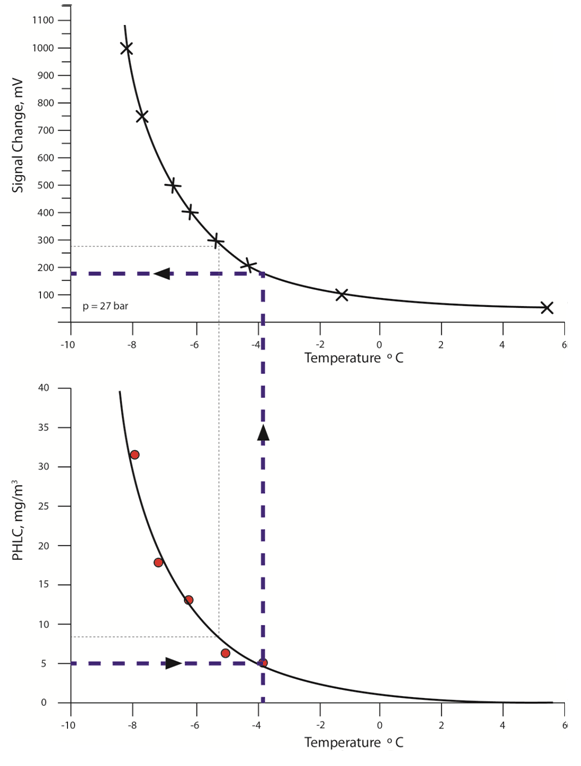
|
Conclusion
Calibration methods applied to on-line HC dew point analysers have evolved over time. Michell Instruments
is able to support our customers in applying their preferred method to their Condumax I/II. The superior
detection sensitivity of the Condumax II is proven capable of making measurements to even the most stringent
implementations of HC dew point measurement, so ensuring that our customers apply best measurement practices
both now and into the future.
Notes
- UKAS: United Kingdom Accreditation Service www.UKAS.org.uk
- GERG: European Gas Research Group www.gerg.eu
- European Gas Technology Conference organized under the joint auspices of MARCOGAZ and GERG together
representing the complete technological arm of the European gas industry www.egatec2013.com
Copyright: Michell Instruments Limited, Ely, UK - 23 May 2013
|
|
|
|
|
|